Most Popular Beverages in Nepal
Nepal's beverage culture encompasses a wide array of traditional and modern drinks that cater to diverse tastes and preferences.
Nepal's beverage culture encompasses a wide array of traditional and modern drinks that cater to diverse tastes and preferences.
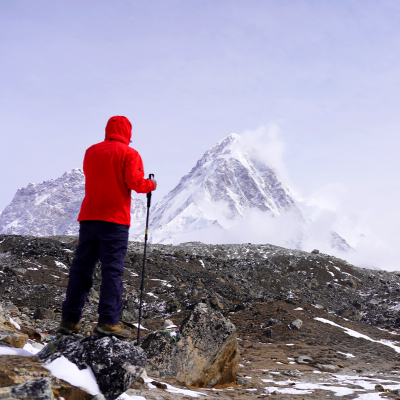
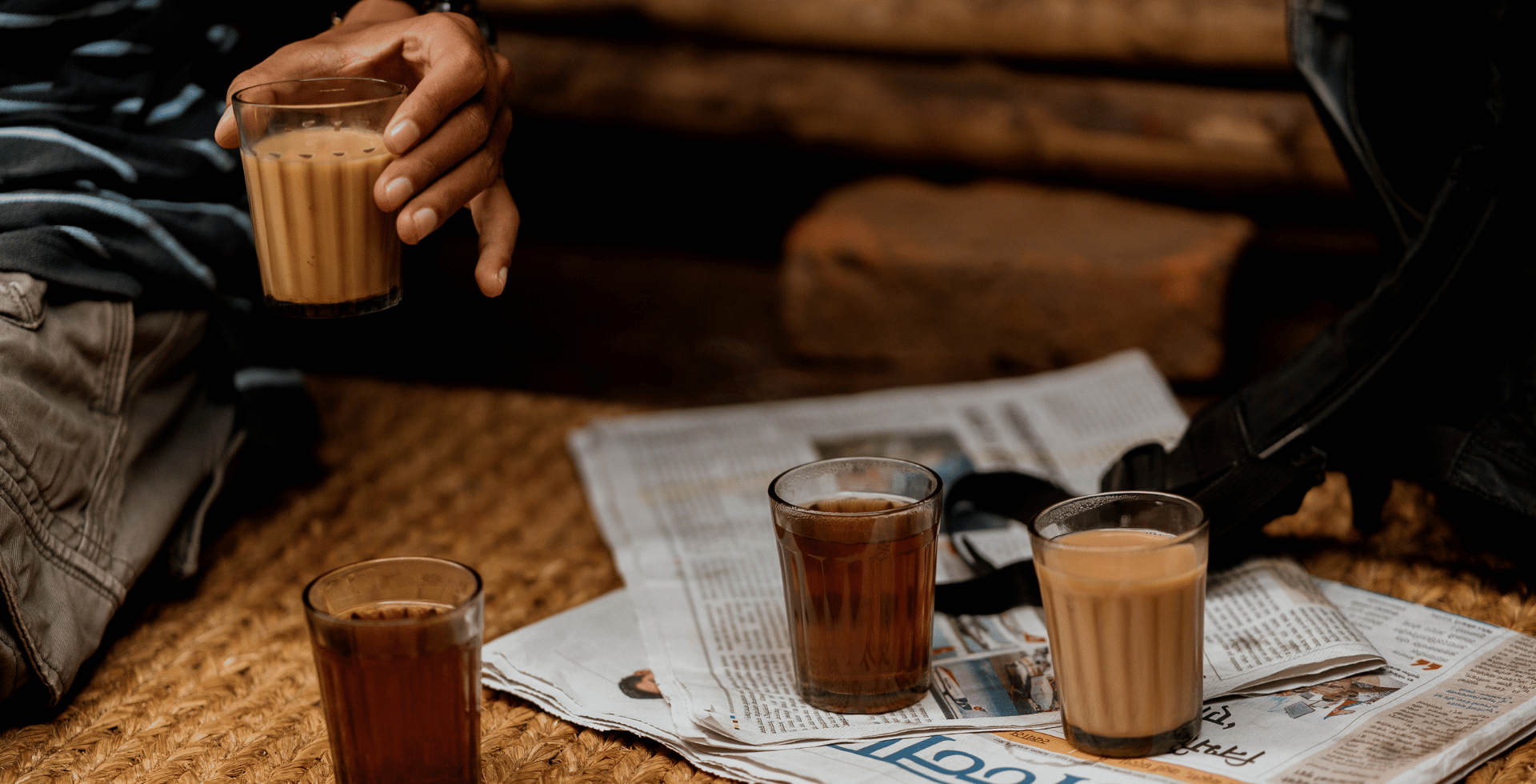
Nepal, a small yet culturally and geographically diverse country, boasts an equally diverse and fascinating beverage culture. Nestled between India, Tibet, and China, Nepal has been influenced by its neighbors in many aspects, including its beverages. The country's unique geography, from the towering peaks of the Himalayas to the lush plains of the Terai region, has also played a role in shaping the beverage culture.
Traditional beverages, both alcoholic and non-alcoholic, have long been an integral part of Nepali culture. Alcoholic drinks such as Chyang, Raksi, Tongba, and Aila are deeply rooted in the country's customs and are often associated with religious rituals, festivals, and social gatherings. These drinks are typically made using local ingredients like millet, rice, and barley and are prepared through traditional brewing and distilling techniques.
Non-alcoholic beverages are equally popular and varied in Nepal. Lassi, a yogurt-based drink, is enjoyed in sweet or savory forms and often includes fruits or spices. Chiya, the Nepali version of tea, is a staple beverage, with many regional variations, including the famous milk tea with spices known as Masala Chiya. Shikanji, a lemon-based drink, and Juju Dhau, a creamy yogurt from Bhaktapur, are other examples of popular non-alcoholic beverages.
In recent years, the influence of globalization has led to the growth of modern and international beverages in Nepal. The coffee culture has been on the rise, with an increasing number of coffee shops and cafes emerging in urban areas. Many of these establishments offer locally-grown coffee beans from regions like Nuwakot, Palpa, and Gulmi, contributing to the growth of Nepal's coffee industry. Soft drinks and bottled beverages from both international and domestic brands are also widely available throughout the country.
Additionally, beverages for health and well-being are gaining popularity. Herbal teas, made from a variety of plants and spices, have been a part of traditional Nepali medicine for centuries. These teas are believed to have various health benefits, such as boosting immunity and improving digestion. The influence of Ayurveda has also led to the popularity of Ayurvedic drinks that are meant to balance the body's energies and promote overall wellness.
Nepal's diverse beverage and food culture reflects the country's rich history, geography, and customs. Traditional drinks continue to hold an essential place in Nepali society, while modern and international beverages are becoming increasingly popular. Together, these beverages offer a unique window into the flavors and traditions of Nepal.
The geography and climate of Nepal play a significant role in shaping the country's beverage choices. Nepal's unique topography, comprising the towering peaks of the Himalayas, the hilly regions, and the fertile plains of the Terai, creates distinct microclimates that influence local ingredients and agricultural practices. As a result, beverages from different regions of Nepal often showcase local flavors and resources.
In mountainous regions, where the climate is cold and harsh, beverages are often consumed to provide warmth and energy. Tongba, a traditional millet-based alcoholic drink, is popular in the eastern highlands of Nepal, particularly among the Limbu and Rai communities. This drink is served hot and is known for its warming properties, making it a favored beverage during the cold months. Similarly, butter tea, or Su Cha, is popular in high-altitude regions and among the Sherpa community. It is made from tea leaves, yak butter, and salt, and provides much-needed calories and energy in the cold climate.
In hilly regions, where the climate is more temperate, tea is a widely consumed beverage. Chiya, the Nepali version of tea, is often prepared with milk, sugar, and a blend of spices like cardamom, ginger, and cinnamon. The hilly regions are also home to tea gardens that produce high-quality tea leaves, such as the famous Ilam tea. Locals in these regions usually consume tea multiple times a day, enjoying it as a social drink or a source of comfort and warmth.
In the Terai region, which has a subtropical climate, refreshing and cooling beverages are favored. Lassi, a yogurt-based drink, is popular in this region and is consumed in both sweet and savory forms. It can be prepared with fruits like mangoes and lychees, which are abundant in the Terai, or seasoned with spices like roasted cumin. Another popular drink in this region is Shikanji, a lemon-based drink often flavored with spices and sweetened with sugar or honey. Shikanji is particularly popular during the hot summer months, as it is known for its cooling and hydrating properties.
The geography and climate of Nepal also impact the production and consumption of alcoholic beverages. Raksi, a distilled alcoholic drink, is made from a variety of grains and fruits depending on the region's agricultural resources. In the mountains, barley and millet are more common, while rice is the primary ingredient in the Terai region. Different regions have developed unique beverages that cater to local tastes and utilize locally available ingredients. This diversity in beverage culture is a testament to the adaptability and creativity of the Nepali people.
Nepal's beverage culture encompasses a wide array of traditional and modern drinks that cater to diverse tastes and preferences. In this preview, we will explore some popular traditional and modern beverages that showcase the rich variety of flavors and experiences that Nepal has to offer.
Chyang: A traditional fermented drink made from rice, millet, or barley, Chyang is popular in many Nepali communities, particularly among the Newar people. It has a mildly sour taste and is often enjoyed during festivals and social gatherings.
Raksi: A distilled alcoholic beverage made from grains or fruits, Raksi is popular throughout Nepal. Known for its strong flavor, it is consumed during special occasions, religious ceremonies, and social events.
Tongba: A millet-based alcoholic drink, Tongba is popular in the eastern highlands of Nepal. Served hot, it provides warmth and energy in the colder mountainous regions.
Aila: A potent Newari liquor, Aila is typically made from rice or millet and has cultural and religious significance. It is often consumed during festivals and important life events.
Coffee: With the rise of urbanization and globalization, coffee culture has been growing in Nepal. The country produces its coffee beans, and many cafes offer locally-grown and roasted coffee. The demand for specialty coffee, such as cold brews and espresso-based drinks, has also increased.
Soft Drinks: Both international and domestic brands offer a variety of soft drinks and bottled beverages in Nepal. These drinks are widely available and cater to the growing demand for convenient, ready-to-drink options.
Smoothies and Juices: The popularity of healthy and refreshing drinks has given rise to a growing number of juice bars and smoothie shops. These establishments often use local fruits and vegetables to create unique and flavorful beverages.
Bubble Tea: Originating from Taiwan, bubble tea has become increasingly popular among Nepali youth. This tea-based drink, often mixed with milk and fruit flavors, contains chewy tapioca pearls and is enjoyed as a trendy, modern beverage.
This selection of traditional and modern beverages represents just a glimpse of the diverse and vibrant beverage culture in Nepal. These drinks showcase the country's rich history, the influence of neighboring regions, and the evolving tastes of its people.
Nepali beverages have been influenced by the culinary traditions of neighboring countries such as India, Tibet, and China. This has led to a unique fusion of flavors and ingredients, resulting in a diverse beverage culture.
India's influence on Nepali beverages is evident in the widespread popularity of tea (Chiya) and Lassi, a yogurt-based drink. The spiced milk tea, known as Masala Chiya, is similar to the Indian Masala Chai, while Lassi is enjoyed in various sweet and savory forms throughout Nepal.
Tibetan influence can be seen in the consumption of butter tea (Su Cha) among the high-altitude communities, like the Sherpas. Su Cha is made by blending tea leaves, yak butter, and salt, providing a rich source of energy and warmth in the cold mountainous regions. Similarly, Tongba, a millet-based alcoholic beverage, has its origins in the eastern Himalayan regions and is consumed by communities with Tibetan roots.
Chinese influence is more prominent in the tea culture, especially in the eastern hilly regions of Nepal, where tea gardens produce high-quality tea leaves. The tea-making process and the consumption of green tea are examples of Chinese influence on Nepali beverages.
Local ingredients and customs have played a significant role in shaping Nepal's beverage culture. The country's diverse geography and climate have given rise to a variety of agricultural products, which in turn have shaped the beverages consumed in different regions. For example, the use of millet, barley, and rice in traditional alcoholic beverages like Chyang, Raksi, and Aila can be attributed to the agricultural practices and resources of the region.
Customs and traditional practices also influence the preparation and consumption of beverages. For instance, the Newari community has a strong tradition of brewing Aila, which is often consumed during festivals and important life events. Similarly, the practice of offering Raksi or Aila during religious rituals, as well as its use in social gatherings, reflects the cultural significance of these beverages in Nepali society.
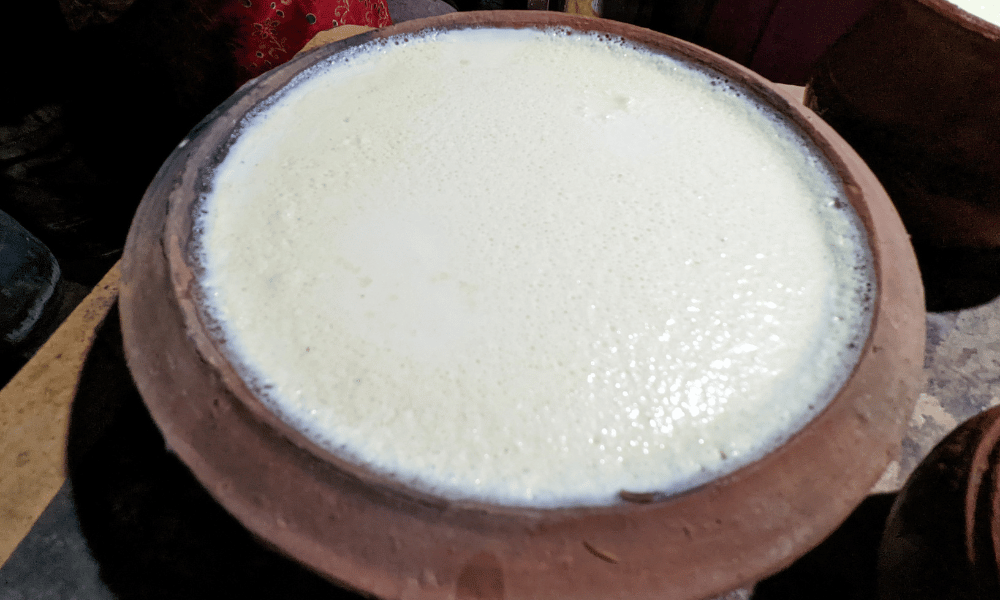
Beverages have held historical significance in Nepali religious and social rituals, serving as symbols of hospitality, celebration, and reverence. Alcoholic beverages like Raksi and Aila have been used as offerings to deities during religious ceremonies, while Chyang is an integral part of various Newari festivals, such as Indra Jatra and Bhimsen Jatra.
In social settings, the consumption of beverages like Raksi and Chyang facilitates bonding and camaraderie. The preparation and sharing of these drinks are seen as gestures of hospitality and goodwill, fostering a sense of community among the participants.
The history of Nepali beverages is shaped by the influence of neighboring countries, the use of local ingredients, and the importance of customs and rituals. This rich history has given rise to a diverse and vibrant beverage culture that reflects the country's unique traditions and geography.
Nepal's diverse beverage culture reflects the country's rich history, geography, and customs. Traditional drinks continue to hold an essential place in Nepali society with their increasing popularity among the youth.
Chyang, also known as Jand or Thon, is a traditional fermented drink popular in Nepal, especially among the Newar community as a staple dish of Newari cuisine. It has a slightly sour, tangy taste and a cloudy appearance. Chyang is typically served in a brass or earthenware bowl called a "Bhaa" or "Dhunge Dhara." The drink has a low alcohol content, making it suitable for consumption at various social gatherings, religious events, and celebrations.
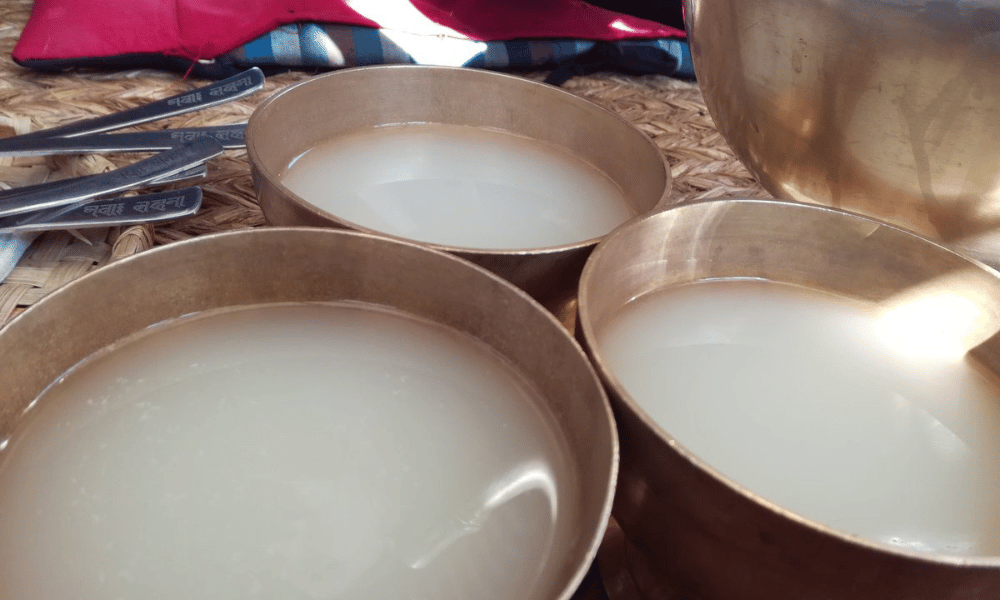
Chyang holds cultural significance in Nepali society, particularly for the Newar people. It is an integral part of various festivals, such as Indra Jatra, Bhimsen Jatra, and Sithi Nakha. The drink is also consumed during special occasions like weddings, rice-feeding ceremonies, and family gatherings. The preparation and sharing of Chyang are considered symbols of hospitality and good fortune, fostering a sense of unity among those who partake in it.
Ingredients and preparation
Chyang is made using grains like rice, millet, or barley, which serve as the base ingredient. The grains are soaked, drained, and then spread out on a mat or cloth to allow them to germinate. This process, known as malting, helps convert the grains' starches into fermentable sugars. Once the grains have sprouted, they are dried and ground into a fine powder, which is then mixed with water to create a thick mash. This mash is traditionally placed in an earthen pot and left to ferment for a few days, usually at room temperature.
During the fermentation process, a starter culture called "Marcha" or "Murcha" is added to the mash. Marcha is a combination of various molds, yeasts, and bacteria that help break down the sugars in the grains and convert them into alcohol. The Marcha starter is typically made from rice flour and is unique to the region or the family preparing the Chyang.
After the fermentation period, the mash is strained through a cloth or sieve, and the liquid collected is the Chyang. The drink can be consumed immediately, but it is often left to mature for a few more days to develop a richer flavor. Chyang can be enjoyed at room temperature or chilled, depending on personal preferences and the weather.
Raksi, also known as Araq or Nepali wine, is a potent distilled alcoholic beverage popular throughout Nepal. It is a clear, colorless liquid with a strong, distinct aroma and taste. Raksi is often compared to moonshine or homemade spirits due to its high alcohol content, which can range from 40% to 60% or even higher. The drink is traditionally consumed during special occasions, religious ceremonies, and social events.
There are regional variations in Raksi, with differences in ingredients, flavors, and preparation techniques. In the mountainous regions, Raksi is typically made from barley or millet, while in the Terai region, rice is the primary ingredient. Some variations may also include fruits like apples or other local fruits as the base ingredient. The flavor of Raksi can vary depending on the type of grain or fruit used, as well as the specific distillation process followed.
Ingredients and preparation
Raksi is made from grains like rice, millet, or barley, or fruits, depending on the region and availability of resources. The process of making Raksi involves fermentation and distillation.
To prepare Raksi, the grains or fruits are first soaked, drained, and then spread out on a mat or cloth to allow them to germinate (in the case of grains). Once the grains have sprouted, they are dried and ground into a fine powder, which is then mixed with water to create a thick mash. Fruits are typically crushed or mashed to extract their juice, which is then mixed with water.
A starter culture, called "Marcha" or "Murcha," is added to the mash or fruit juice mixture to initiate fermentation. The mixture is placed in an earthen pot, covered with a cloth, and left to ferment at room temperature for several days. The duration of the fermentation process can vary depending on the specific recipe and regional preferences.
After fermentation, the liquid is distilled to separate the alcohol from the residual solids and water. Traditional distillation methods involve the use of a simple pot still, consisting of a copper or brass container (called "Bhatti") with a long, coiled tube (called "Lau") attached to it. The fermented liquid is heated in the Bhatti, and as the alcohol evaporates, it passes through the Lau, where it cools down and condenses back into a liquid. This liquid, which is the Raksi, is collected in a separate container.
The distillation process may be carried out once or multiple times, depending on the desired strength and purity of the final product. The resulting Raksi can be consumed immediately or left to mature for a few weeks or months to develop a smoother, more refined taste.
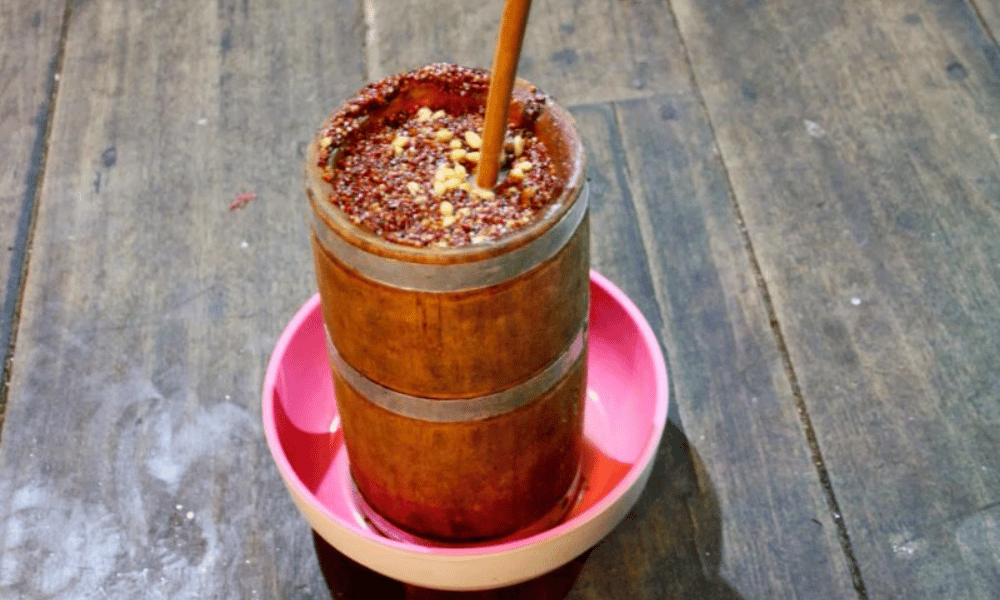
Tongba, also known as millet beer or hot beer, is a traditional fermented alcoholic drink popular in the eastern highlands of Nepal, particularly among the Limbu and Rai communities. It is a warm, mildly alcoholic beverage that provides warmth and energy in the cold, harsh climates of the mountainous regions. Tongba holds cultural significance in the eastern region, where it is often consumed during social gatherings, religious ceremonies, and special occasions.
Ingredients and preparation
Tongba is made primarily from finger millet, which is a staple grain in the eastern highlands of Nepal. The preparation process involves fermenting the millet and then extracting the alcohol by pouring hot water over the fermented grains.
To make Tongba, the finger millet is first soaked in water for a few hours or overnight. After soaking, the grains are drained and spread out on a mat or cloth to allow them to germinate, a process called malting. The germination process usually takes a few days, during which the grains are regularly turned and checked for sprouting.
Once the grains have sprouted, they are dried, either in the sun or over a fire, and then ground into a fine powder. The powder is mixed with water and a starter culture, usually the same "Marcha" or "Murcha" used for other traditional Nepali beverages. The mixture is placed in an earthen pot and left to ferment at room temperature for about a week or longer, depending on the desired strength and taste.
After the fermentation process, the fermented millet is typically transferred to a large container or traditional wooden vessel called "Tongba." To serve the drink, hot water is poured over the fermented millet, and the liquid is allowed to steep for a few minutes. The beverage is then sipped through a bamboo straw called "Pipsinge" or "Sipsing," which is designed to filter out the solid millet grains while allowing the warm, alcoholic liquid to be consumed.
Tongba can be enjoyed in multiple rounds by adding more hot water to the fermented millet, extracting more of the alcohol and flavor until the grains are exhausted. The drink is best enjoyed warm, making it a comforting and energizing beverage during the cold months in the eastern highlands of Nepal.
Aila, also known as Newari liquor, is a potent distilled alcoholic beverage native to the Newar community of Nepal. The drink is clear, colorless, and has a strong, aromatic flavor. With an alcohol content ranging from 40% to 60% or even higher, Aila is considered one of the strongest traditional liquors in Nepal.
Aila holds significant cultural importance among the Newar people, as it is deeply intertwined with their customs, rituals, and festivities. The beverage is consumed during religious ceremonies, life events such as weddings and rice-feeding ceremonies, and cultural festivals like Indra Jatra and Jyapu Diwas. The preparation and sharing of Aila are seen as expressions of hospitality, and the drink is believed to promote good fortune and spiritual strength.
Ingredients and preparation
Aila is typically made from grains, such as rice or millet, which serve as the base ingredient. The preparation process involves fermentation and distillation, similar to that of Raksi.
To prepare Aila, the grains are first soaked, drained, and then spread out on a mat or cloth to allow them to germinate. This malting process helps convert the grains' starches into fermentable sugars. Once the grains have sprouted, they are dried and ground into a fine powder, which is then mixed with water to create a thick mash.
A starter culture, called "Marcha" or "Murcha," is added to the mash to initiate fermentation. The mixture is placed in an earthen pot, covered with a cloth, and left to ferment at room temperature for several days. The duration of the fermentation process can vary depending on the specific recipe and regional preferences.
After fermentation, the liquid is distilled to separate the alcohol from the residual solids and water. Traditional distillation methods involve the use of a simple pot still, consisting of a copper or brass container with a long, coiled tube attached to it. The fermented liquid is heated, and as the alcohol evaporates, it passes through the tube, where it cools down and condenses back into a liquid. This liquid, which is the Aila, is collected in a separate container.
The distillation process may be carried out once or multiple times, depending on the desired strength and purity of the final product. The resulting Aila can be consumed immediately or left to mature for a few weeks or months to develop a smoother, more refined taste. Aila is often served in a small, ornate cup called "Aanchara," which is used exclusively for drinking this potent liquor.
Aside from traditional alcoholic drinks, Nepal flaunts an even wider variety of non-alcoholic beverages catering to everyone's tastebuds.
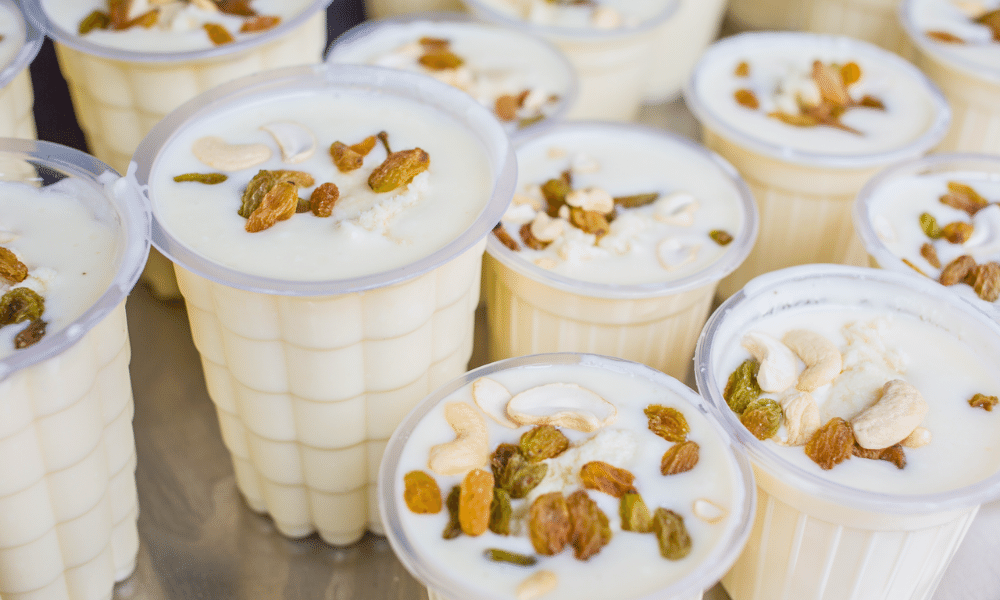
Lassi is a popular yogurt-based drink that originated in the Indian subcontinent and is widely enjoyed in Nepal as well. It is a cooling, refreshing beverage that is consumed in both sweet and savory forms. Lassi is often served as a chilled drink, making it a popular choice to beat the heat during hot summer months.
There are several regional variations of Lassi in Nepal, influenced by local tastes and ingredients. Some of the popular variations include:
Sweet Lassi: Made with yogurt, sugar, and often flavored with cardamom, saffron, or rose water, sweet Lassi is a favorite among those who enjoy a mildly sweet and refreshing beverage.
Salted Lassi: Also known as Namkeen Lassi, this savory version is made with yogurt, salt, and sometimes seasoned with roasted cumin powder and black pepper. It is often enjoyed as a digestive aid and a refreshing accompaniment to meals.
Mango Lassi: This fruity variation is made by blending yogurt with ripe mangoes, sugar, and sometimes a pinch of cardamom or saffron for added flavor. Mango Lassi is especially popular during the mango season.
Mint Lassi: A refreshing and cooling version of Lassi, made by blending yogurt with fresh mint leaves, sugar, and a pinch of salt. This variation is perfect for hot summer days.
Ingredients and preparation
The basic ingredients for Lassi include yogurt, water or milk, and sugar or salt, depending on whether it's a sweet or savory version. Additional flavorings like fruits, spices, or herbs can be added based on personal preferences and regional variations.
To prepare Lassi, follow these general steps:
Begin with fresh, chilled yogurt. Whisk the yogurt in a bowl or blend it in a blender to make it smooth and creamy.
Add water or milk to the yogurt to achieve the desired consistency. For a thicker Lassi, use less liquid, while for a thinner consistency, add more liquid. Adjust the proportions based on your preference.
Add sugar or salt, depending on whether you're making a sweet or savory Lassi. Adjust the sweetness or saltiness to your taste.
If you're making a flavored Lassi, such as Mango Lassi, blend the yogurt with chopped ripe mangoes or mango pulp. For Mint Lassi, blend the yogurt with fresh mint leaves.
For added flavor, you can also include spices like cardamom, saffron, or roasted cumin powder.
Blend all the ingredients together until smooth and frothy.
Pour the Lassi into glasses, and garnish with a sprig of mint, a pinch of ground spices, or a drizzle of rose water, if desired. Serve chilled.
Lassi can be easily customized with various fruits, spices, and flavorings, making it a versatile and refreshing beverage enjoyed throughout Nepal.
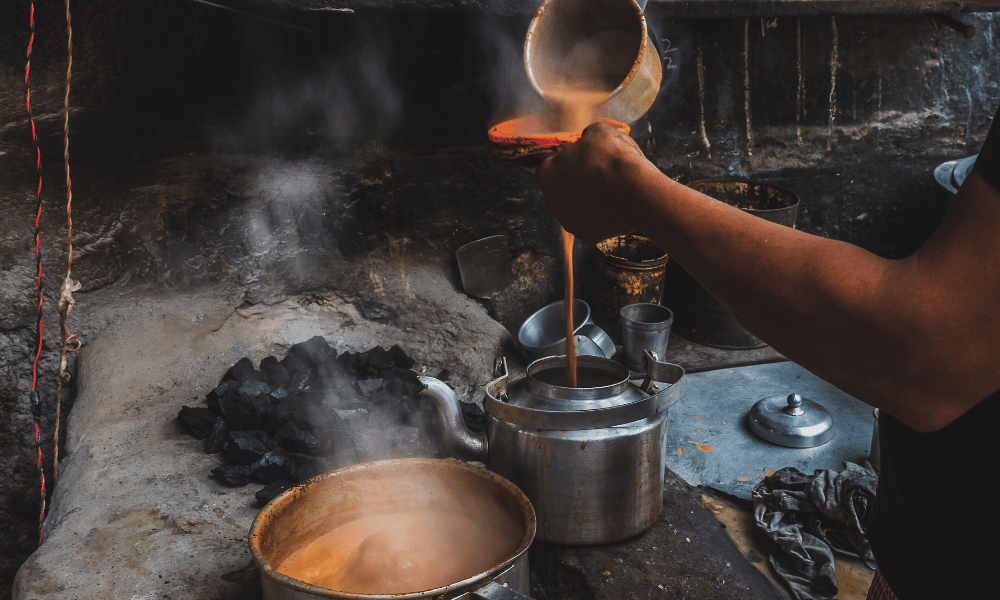
Chiya, also known as Nepali tea or Masala tea, is a popular hot beverage consumed widely throughout Nepal. It is a spiced tea that typically combines black tea leaves with a blend of spices, milk, and sugar. Chiya is an integral part of the daily routine for many Nepalis, often enjoyed in the morning, during afternoon breaks, or as a warm and comforting drink during colder months.
Tea culture in Nepal dates back centuries, with tea being an important part of social interactions and hospitality. Offering tea to guests is a common gesture of warmth and welcome in Nepali households. Tea stalls, known as "Chiya Pasals" or "Chiya Khaneys," can be found across the country, serving various types of tea, including the traditional spiced Chiya and other regional varieties.
Ingredients and preparation
The primary ingredients for making Chiya include black tea leaves, milk, water, sugar, and a blend of spices. The spices used in Chiya can vary, but some of the most common ones include cardamom, cinnamon, cloves, ginger, and black pepper.
To prepare Chiya, follow these general steps:
In a saucepan, add water and the spices of your choice, such as crushed cardamom pods, cinnamon sticks, cloves, grated ginger, and black pepper. Bring the water to a boil and let the spices simmer for a few minutes to release their flavors.
Add the black tea leaves to the boiling water and let them steep for 2-3 minutes, depending on the desired strength of the tea. You can use loose tea leaves or tea bags, depending on your preference.
Once the tea has reached the desired strength, add milk to the saucepan. The amount of milk can be adjusted based on personal preferences, with more milk resulting in a creamier, milder tea, and less milk yielding a stronger, more robust flavor.
Add sugar to taste, keeping in mind that traditional Nepali Chiya is often sweetened generously.
Allow the mixture to simmer for another minute or two, then strain the tea into cups or glasses, removing the spices and tea leaves.
Serve the Chiya hot, accompanied by biscuits, snacks, or traditional Nepali sweets, if desired.
Chiya is a warming and aromatic beverage that reflects the rich tea culture of Nepal, bringing people together and providing comfort on cold days.
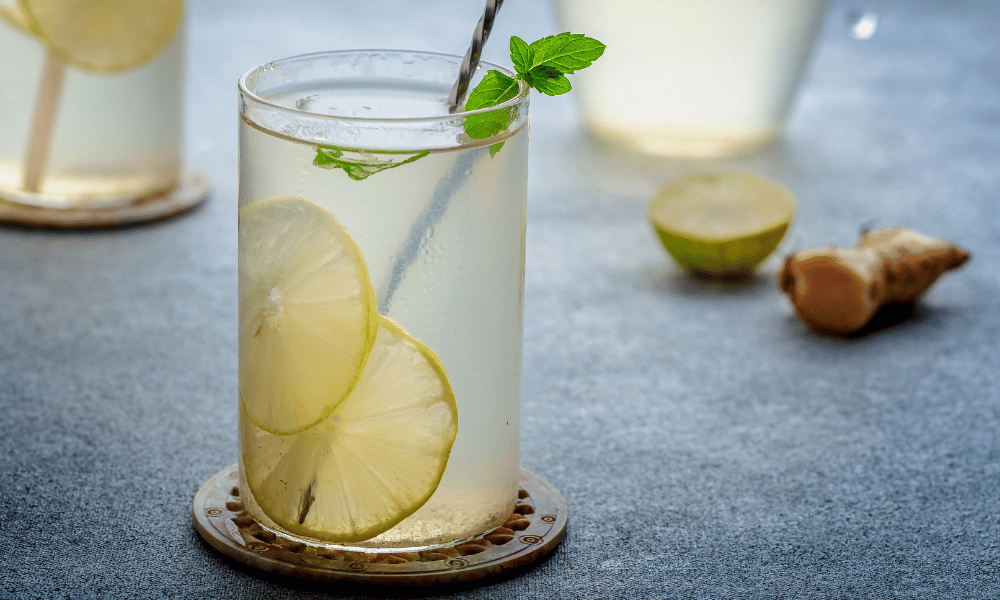
Shikanji, also known as Shikanjvi or Nimbu Pani, is a refreshing, lemon-based drink popular in Nepal, India, and other parts of the Indian subcontinent. It is a perfect summertime beverage, known for its cooling and rejuvenating properties. Shikanji is often consumed as a thirst quencher, a remedy for heat exhaustion, or simply as a flavorful and hydrating drink to enjoy during hot weather.
Shikanji is a versatile drink, with numerous variations that include different fruits, spices, and sweeteners. The beverage is commonly served chilled or over ice, making it an ideal choice for sipping on a hot day or as a refreshing accompaniment to meals.
Ingredients and preparation
The primary ingredients for making Shikanji include fresh lemon or lime juice, water, sugar or other sweeteners, and a pinch of salt. Additional flavorings, such as black pepper, roasted cumin powder, mint leaves, or ginger, can be added to enhance the taste and create unique variations.
To prepare Shikanji, follow these general steps:
Start by squeezing fresh lemons or limes to extract the juice. Depending on personal preference, you can use more or less juice to achieve the desired level of tartness.
In a large pitcher or jug, combine the lemon or lime juice with water. The proportion of water to juice can be adjusted based on your preference for a stronger or milder flavor.
Sweeten the mixture with sugar or your preferred sweetener, such as honey or jaggery. Stir well to ensure the sweetener dissolves completely in the liquid. Adjust the sweetness to taste.
Add a pinch of salt to the Shikanji, which not only enhances the flavor but also helps replenish lost electrolytes on hot days.
If desired, include additional flavorings, such as a pinch of black pepper, roasted cumin powder, grated ginger, or fresh mint leaves. These ingredients can be mixed into the Shikanji directly or muddled in a separate bowl before being added to the liquid.
Stir the mixture well, and refrigerate it for at least an hour to allow the flavors to meld and the drink to chill.
Before serving, give the Shikanji a quick stir, and pour it over ice in tall glasses. Garnish with fresh mint leaves, lemon slices, or a sprinkle of roasted cumin powder, if desired.
Shikanji is a versatile and invigorating beverage that can be easily customized to suit individual preferences, making it a popular and much-loved summertime favorite in Nepal and beyond.
Juju Dhau, also known as "King of Yogurt" or "King Curd," is a famous sweetened yogurt from Bhaktapur, a historical city located in the Kathmandu Valley of Nepal. Juju Dhau is renowned for its thick, creamy texture and sweet taste, which sets it apart from regular yogurt. It is an essential part of Bhaktapur's culinary and cultural heritage, and visitors to the city often seek out this delectable treat.
Juju Dhau holds cultural significance in Bhaktapur, as it is often served during festivals, religious ceremonies, and special occasions such as weddings and rice-feeding ceremonies. Offering Juju Dhau to guests is a gesture of hospitality, and the sweet yogurt is believed to bring good fortune and blessings.
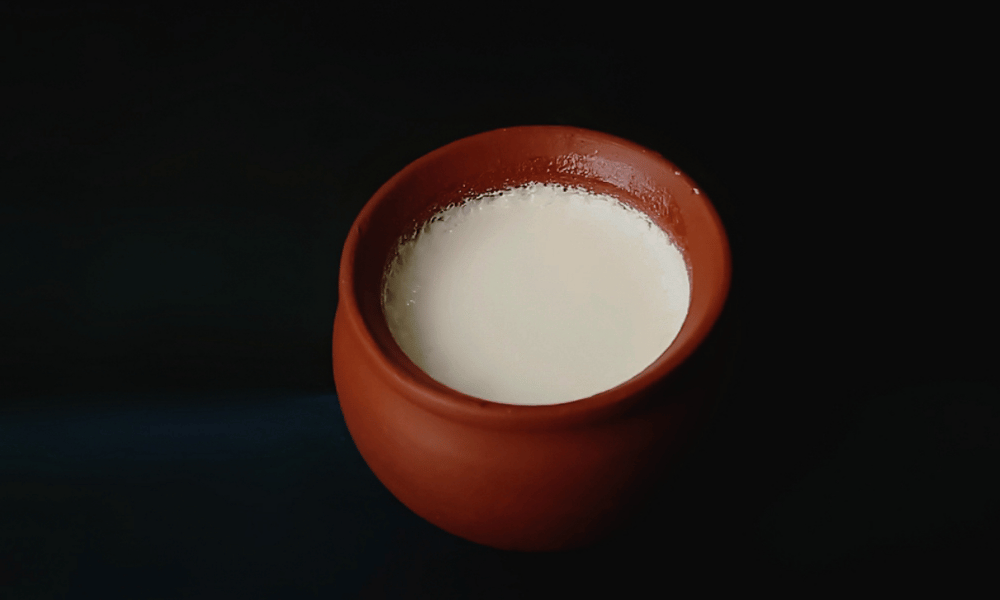
Ingredients and preparation
Juju Dhau is made from buffalo milk, sugar, and a yogurt starter culture. The preparation process involves boiling and sweetening the milk, cooling it to a suitable temperature, and then adding the starter culture to initiate fermentation. The yogurt is traditionally set in small, round clay pots, which are believed to impart a distinct flavor and help achieve the desired thick consistency.
To prepare Juju Dhau, follow these general steps:
Start by boiling buffalo milk in a large saucepan, stirring occasionally to prevent it from sticking to the bottom or forming a skin. The use of buffalo milk is crucial, as it has a higher fat content compared to cow's milk, which contributes to the rich, creamy texture of Juju Dhau.
Once the milk has reached a boil, reduce the heat and let it simmer for a few minutes. Then, add sugar to the milk, stirring to dissolve it completely. Adjust the sweetness to taste, keeping in mind that traditional Juju Dhau is often quite sweet.
Remove the saucepan from the heat and allow the milk to cool down to lukewarm, around 110-115°F (43-46°C). It is essential to ensure that the milk is not too hot, as high temperatures can kill the yogurt starter culture.
Once the milk has reached the appropriate temperature, add a small amount of yogurt starter culture to the saucepan, stirring gently to mix it in evenly. The starter culture can be a store-bought yogurt culture or a few tablespoons of previously made yogurt.
Pour the milk mixture into small, clean clay pots, filling them almost to the top. The clay pots help wick away moisture, allowing the yogurt to set and achieve the desired thick consistency.
Cover the pots with a clean cloth or lid and place them in a warm, draft-free location to set. The yogurt will typically take around 6-8 hours to set, depending on the ambient temperature. In colder environments, the pots can be placed in a warm oven (turned off) or wrapped in a blanket to maintain a consistent temperature.
Once the yogurt has set and achieved a thick, creamy consistency, refrigerate the pots to chill the Juju Dhau before serving.
Juju Dhau is best enjoyed chilled, either on its own or as a refreshing accompaniment to a meal. The unique texture and flavor of this traditional yogurt from Bhaktapur make it a beloved treat for locals and visitors alike.
Let's explore some popular international and modern beverages that showcase the rich variety of flavors and experiences that Nepal has to offer.
Over the past couple of decades, coffee culture in Nepal has grown significantly, especially in urban areas such as Kathmandu, Pokhara, and other major cities. The increasing number of coffee shops, cafés, and specialty coffee houses reflects the rising demand for quality coffee among locals and tourists alike. These establishments offer a wide range of coffee beverages, from classic espresso-based drinks like cappuccinos and lattes to more innovative concoctions featuring local flavors and ingredients.

The burgeoning coffee culture in Nepal can be attributed to several factors. The influence of global coffee chains and their introduction to the country has played a role in popularizing coffee and fostering a café culture. Additionally, the younger generation's exposure to international trends and a growing middle class have contributed to the demand for specialty coffee shops and unique experiences. Coffee shops in Nepal often serve as social hubs, providing a relaxed environment for people to meet, work, and unwind.
Nepali-grown coffee beans and local brands
Nepal is not only a consumer of coffee but also a producer. The country's climate and geography, particularly in the hilly regions, make it suitable for growing high-quality coffee beans. Most of the coffee produced in Nepal is of the Arabica variety, which is known for its mild and nuanced flavors. Coffee production in Nepal began in the late 20th century and has since been expanding steadily, with more farmers engaging in coffee cultivation as a means to diversify their income sources.
Several local coffee brands and roasters are gaining recognition both nationally and internationally for their Nepali-grown coffee beans. Some of these brands include Himalayan Java, Karma Coffee, Lekali Coffee Estate, and Nepal Coffee Company, among others. These brands emphasize the importance of sustainable and ethical farming practices, often working directly with smallholder farmers to ensure fair wages and support local communities.
Nepali coffee is gaining a reputation for its distinct flavor profiles, with many beans exhibiting fruity, floral, and even wine-like notes. The increasing interest in specialty coffee and the growth of the coffee culture in Nepal have led to more experimentation with different processing methods, brewing techniques, and flavor combinations, resulting in a dynamic and thriving coffee scene.
Coffee culture in Nepal is on the rise, with a growing number of coffee shops and a strong focus on locally-grown, high-quality beans. This has led to the emergence of a vibrant coffee scene that caters to the tastes and preferences of both locals and visitors, while also supporting local farmers and sustainable practices.
In recent years, beer consumption in Nepal has been on the rise, with an increasing number of people opting for this popular alcoholic beverage. This growth can be attributed to several factors, including the influence of international trends, increased disposable income, and a general shift towards a more liberal attitude towards alcohol consumption. As a result, beer has become a popular choice for socializing and relaxing in Nepal, particularly among the younger generation.

The growing popularity of beer has also led to a rise in the number of bars, pubs, and restaurants that offer a wide selection of both international and local beer brands. These establishments cater to various tastes and preferences, with many offering a cozy and welcoming atmosphere for patrons to unwind and enjoy a cold brew.
Nepal-brewed beers and local brands
In response to the increasing demand for beer, several local breweries have emerged in Nepal, producing a variety of beers that cater to the local palate. Nepali breweries often use local ingredients and traditional brewing techniques, resulting in unique and flavorful beer offerings. Some of the most popular local beer brands in Nepal include:
In addition to these local brands, many international beers are also available in Nepal, catering to diverse preferences and tastes. The growth of the beer industry in Nepal has not only provided consumers with a wider selection of beers to choose from but has also contributed to the country's economy and the promotion of local products.
In Nepal, soft drinks and bottled beverages are popular among consumers, with a wide range of options available in the market. International brands such as Coca-Cola, Pepsi, Fanta, Sprite, and Mountain Dew are widely consumed across the country. These brands have been successful in establishing a strong presence in Nepal through aggressive marketing campaigns, sponsorships, and collaborations with local businesses. As a result, they enjoy significant popularity and have become an integral part of the Nepali beverage landscape. These soft drinks are readily available in most stores, restaurants, and roadside stalls, making them easily accessible to consumers.

Nepali-made soft drinks and juices
In addition to international brands, there are several locally made soft drinks and juices available in Nepal that cater to the taste preferences of the Nepali population. These beverages are often made using local ingredients and traditional recipes, giving them a unique and authentic flavor profile. Some popular Nepali-made soft drinks and juices include:
Frooti: A popular mango-flavored drink produced by the Varun Beverages Nepal Pvt. Ltd., Frooti is a favorite among children and adults alike. Made from mango pulp and available in various sizes, Frooti is enjoyed as a refreshing and fruity beverage.
Rio: A Nepali brand of carbonated fruit drinks, Rio offers a range of flavors, including orange, lemon, pineapple, and mango. Produced by Himganga Beverage Pvt. Ltd., Rio has gained popularity due to its unique flavors and affordable price.
Dabur Real Fruit Juices: Dabur Nepal produces a range of fruit juices under the brand name "Real." These juices are made from high-quality fruit concentrates and come in a variety of flavors, such as mixed fruit, mango, orange, and apple.
Apart from these brands, there are also numerous local producers of fruit juices, lassis, and other traditional beverages that cater to the diverse taste preferences of Nepali consumers. The availability of both international and local soft drinks and bottled beverages offers consumers a wide range of choices, allowing them to enjoy their favorite beverages while also supporting local businesses and products.
The use of local herbs, spices, natural ingredients, and Ayurvedic principles in Nepalese drinks reflects the rich diversity of the country and the longstanding tradition of using natural remedies for overall well-being.
Herbal teas have been an integral part of Nepali culture for centuries. These teas, often derived from a blend of herbs, spices, and other plant materials, have been used for their medicinal properties and therapeutic benefits. Some of the most common traditional medicinal teas and their benefits include:
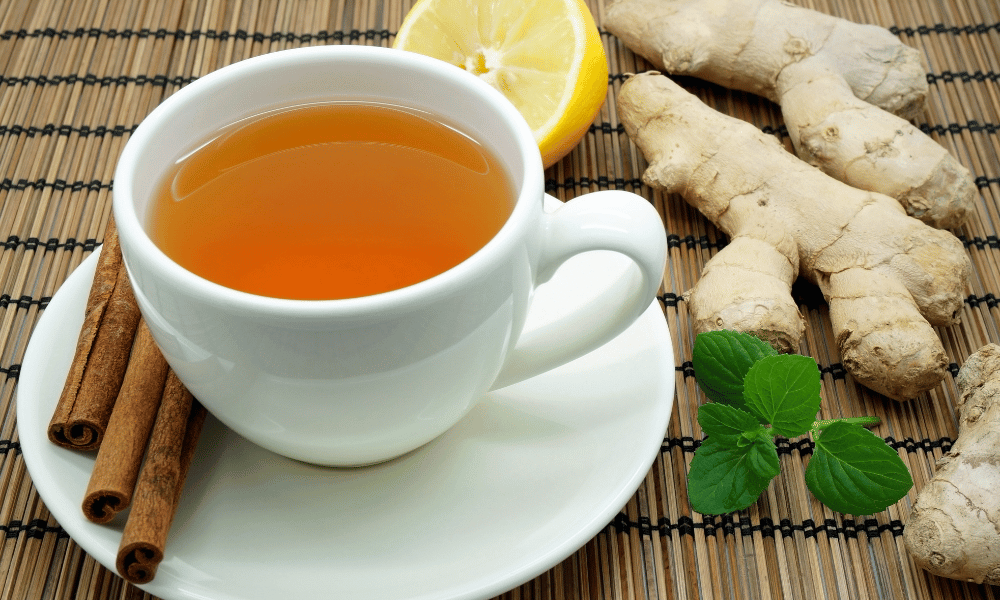
a. Tulsi Tea: Tulsi, also known as Holy Basil, is a sacred plant in Hinduism and is commonly used in herbal teas for its health benefits. Tulsi tea is known to have antioxidant, anti-inflammatory, and adaptogenic properties. It can help reduce stress, support the immune system, and promote mental clarity.
b. Rhododendron Tea: Rhododendron, the national flower of Nepal, is used to make a mild, fragrant tea that is believed to have various health benefits. It is said to aid digestion, improve blood circulation, and help with respiratory issues.
c. Ginger Tea: Ginger tea is a popular beverage in Nepal, known for its warming and invigorating properties. It is believed to help with digestion, alleviate nausea, reduce inflammation, and provide relief from cold and flu symptoms.
d. Lemongrass Tea: Lemongrass tea is known for its calming and soothing effects. It is often consumed to help with digestion, reduce anxiety, and promote overall relaxation.
Ingredients and preparation
Preparing herbal teas typically involves steeping the herbs, spices, or other plant materials in hot water to extract their flavors and beneficial compounds. Here are some general steps to prepare a simple herbal tea:
Start by selecting the herbs, spices, or other plant materials that you wish to use. You can use fresh or dried ingredients, depending on availability and preference.
If using fresh herbs, rinse them thoroughly to remove any dirt or debris. For dried herbs or spices, measure out the desired quantity. Generally, use about one teaspoon of dried herbs or one tablespoon of fresh herbs for each cup of water.
Bring water to a boil in a kettle or saucepan. Once boiling, remove the water from heat and let it cool for a minute to avoid scalding the herbs, which could affect their flavor and medicinal properties.
Place the herbs in a teapot, tea infuser, or directly into a cup. Pour the hot water over the herbs, ensuring they are fully submerged.
Allow the tea to steep for about 5 to 10 minutes, depending on the desired strength and flavor. Some herbs may require longer steeping times to fully release their beneficial compounds.
Once the tea has reached the desired strength, strain the liquid to remove the herbs or spices. You can sweeten the tea with honey or sugar if desired, but many herbal teas have a pleasant flavor without any added sweeteners.
Enjoy your herbal tea while it is still warm to fully appreciate its flavors and therapeutic benefits.
Herbal teas are an essential part of Nepali culture, offering a range of health benefits and therapeutic properties.
Ayurveda, a traditional system of medicine originating from India, has had a significant influence on Nepali culture, including its beverage culture. Many of the herbs and spices used in Nepali cuisine and beverages have Ayurvedic properties, which are believed to promote overall health and well-being. Ayurvedic principles focus on achieving balance among the body's doshas (Vata, Pitta, and Kapha) and using natural ingredients to prevent and treat various ailments. As a result, Ayurvedic drinks have become an integral part of Nepali culture, offering a holistic approach to health and wellness.
Popular Ayurvedic concoctions and their benefits
a. Golden Milk (Haldi Doodh): Golden milk, also known as turmeric milk or haldi doodh, is a popular Ayurvedic drink made from milk, turmeric, and other spices such as black pepper, ginger, and cinnamon. It is believed to have anti-inflammatory and antioxidant properties, which can help boost the immune system, alleviate pain, and promote overall well-being.
b. Ashwagandha Tea: Ashwagandha, a powerful adaptogenic herb, is often used in Ayurvedic teas for its stress-relieving and rejuvenating properties. Ashwagandha tea is believed to help reduce anxiety, improve sleep, and enhance cognitive function.
c. Triphala Tea: Triphala, a blend of three fruits (amla, haritaki, and bibhitaki), is commonly used in Ayurvedic medicine for its detoxifying and rejuvenating properties. Triphala tea is believed to help improve digestion, support the immune system, and promote overall well-being.
d. Cumin-Coriander-Fennel (CCF) Tea: CCF tea is a blend of cumin, coriander, and fennel seeds, which are known for their digestive and detoxifying properties. This Ayurvedic tea is believed to help balance the body's doshas, support digestion, and reduce bloating.
e. Amla Juice: Amla, also known as Indian gooseberry, is a potent source of antioxidants and vitamin C. Amla juice is often consumed in Nepal for its immune-boosting and anti-aging properties. It is also believed to help improve digestion, support liver function, and promote healthy skin and hair.
These Ayurvedic drinks and others play an essential role in Nepali beverage culture, with many people consuming them regularly to maintain good health and achieve balance in their bodies. The use of Ayurvedic principles and natural ingredients in these beverages reflects the deep connection between Nepali culture and traditional medicine, offering a holistic approach to health and wellness.
Beverages, both alcoholic and non-alcoholic, play an essential role in Nepali social settings and gatherings. They are often used to bring people together, facilitate conversation, and celebrate various occasions, such as weddings, festivals, and family events. Traditional beverages, like raksi and aila, are commonly served during these gatherings, while tea, such as chiya, is often enjoyed during informal meetings or casual socializing. Serving beverages is seen as a sign of hospitality, and guests are usually offered a drink as soon as they arrive at someone's home.
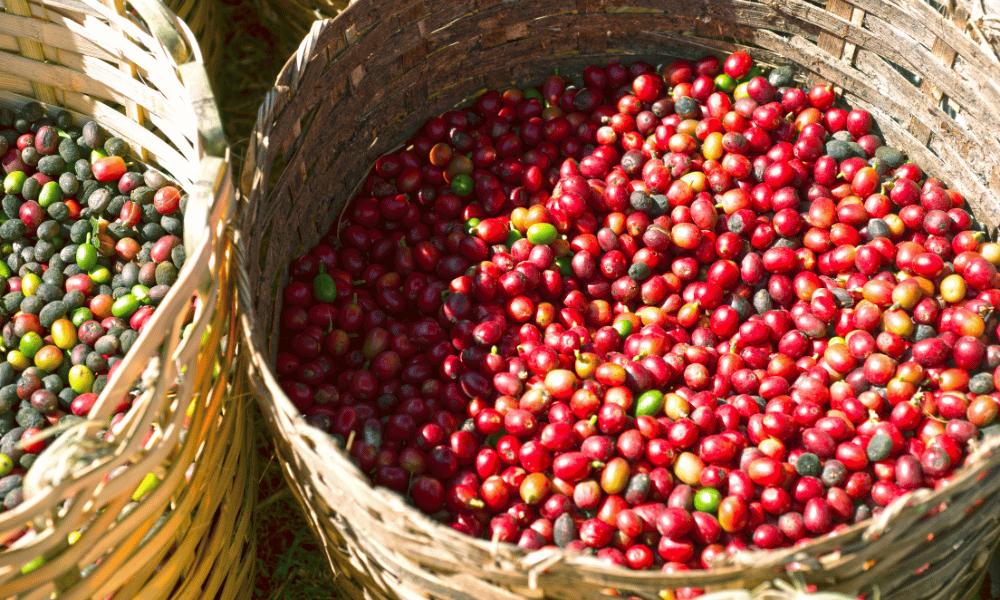
In Nepal, certain customs and etiquette are associated with consuming beverages, especially alcoholic ones. Some of these traditions include:
Offering the first sip: Before consuming any alcoholic beverage, it is customary to offer the first sip to the gods as a sign of respect and gratitude. This is usually done by pouring a small amount onto the ground or into a small container.
Drinking in moderation: While consuming alcoholic beverages is generally accepted in Nepali culture, excessive drinking is generally discouraged. It is considered respectful to drink in moderation and remain composed during social gatherings.
Using both hands: When offering or receiving a beverage, it is polite to use both hands to hold the glass or cup. This gesture is a sign of respect and gratitude towards the person offering the drink.
Offering refills: In Nepali culture, it is considered hospitable to offer refills to guests when their glass or cup is empty. If a guest does not want a refill, they can politely decline by covering their glass or cup with their hand.
The growing interest in Nepal's traditional beverages has led to the development of beverage tourism and tasting experiences in the country. Tourists and locals alike can now participate in various activities that showcase the rich history and unique flavors of Nepali beverages, such as:
Tea tourism: Tea lovers can visit tea estates in the eastern region of Nepal, such as Ilam and Dhankuta, to learn about the tea-making process and sample different varieties of Nepali tea.
Brewery tours: Several local breweries offer guided tours where visitors can learn about the brewing process, sample various types of beer, and even try their hand at brewing.
Raksi and Aila tastings: Some cultural tours and homestays provide visitors with an opportunity to taste traditional homemade raksi and Aila, learning about the distillation process and the cultural significance of these beverages.
Coffee plantation visits: With the increasing popularity of Nepali coffee, coffee plantation visits have become a popular activity for tourists interested in learning about coffee cultivation and processing, as well as tasting freshly brewed coffee made from locally grown beans.
Beverages play a crucial role in Nepali culture, from social gatherings and traditional customs to tourism and tasting experiences. The diverse range of beverages in Nepal reflects the country's rich cultural heritage and offers unique flavors and experiences for locals and visitors alike.
Nepal's rich and diverse beverage culture is a reflection of its unique history, traditions, and influences from neighboring countries. Preserving and celebrating this cultural heritage is vital to maintaining the country's identity and passing down traditions to future generations. By exploring the various beverages that Nepal has to offer, we can gain a deeper appreciation of its culinary landscape and the people who have shaped it.
Share your experiences with us in the comments section below, or on social media using the hashtag #NepaliBeverageAdventure. We would love to hear about your favorite beverages and the stories behind them, as well as any new discoveries you make along the way. Together, we can celebrate and preserve the unique beverage traditions of Nepal for future generations to enjoy.
Some of the most popular traditional alcoholic beverages in Nepal include chyang, raksi, tongba, and aila. These beverages are often homemade and have significant cultural importance.
Popular non-alcoholic beverages in Nepal include Chiya (Nepali tea), lassi, shikanji, and juju Dhau. These drinks are often enjoyed throughout the day and during social gatherings.
Ayurvedic drinks, deeply rooted in Nepali culture, include golden milk (haldi doodh), ashwagandha tea, triphala tea, cumin-coriander-fennel (CCF) tea, and amla juice. These drinks are believed to have various health benefits and therapeutic properties.
Coffee culture in Nepal has grown significantly in recent years, with an increasing number of coffee shops opening across the country. Additionally, locally-grown coffee beans and Nepali coffee brands are gaining popularity both domestically and internationally.
Nepal has seen a rise in the consumption of beer, with local brands like Gorkha Beer, Everest Beer, Arna Beer, Barhasinghe Beer and Sherpa Craft gaining prominence.
Beverages, both alcoholic and non-alcoholic, play a crucial role in Nepali social settings and gatherings. They are used to bring people together, facilitate conversation, and celebrate various occasions. Serving beverages is also seen as a sign of hospitality.
Nepal offers various beverage tourism experiences, such as tea estate visits, brewery tours, raksi and Aila tastings, and coffee plantation tours. These experiences allow visitors to learn about the production process and sample different beverages unique to Nepal.
Traditional drinking customs in Nepal include offering the first sip to the gods, drinking in moderation, using both hands when offering or receiving a beverage, and offering refills to guests. These customs demonstrate respect and gratitude in social settings.